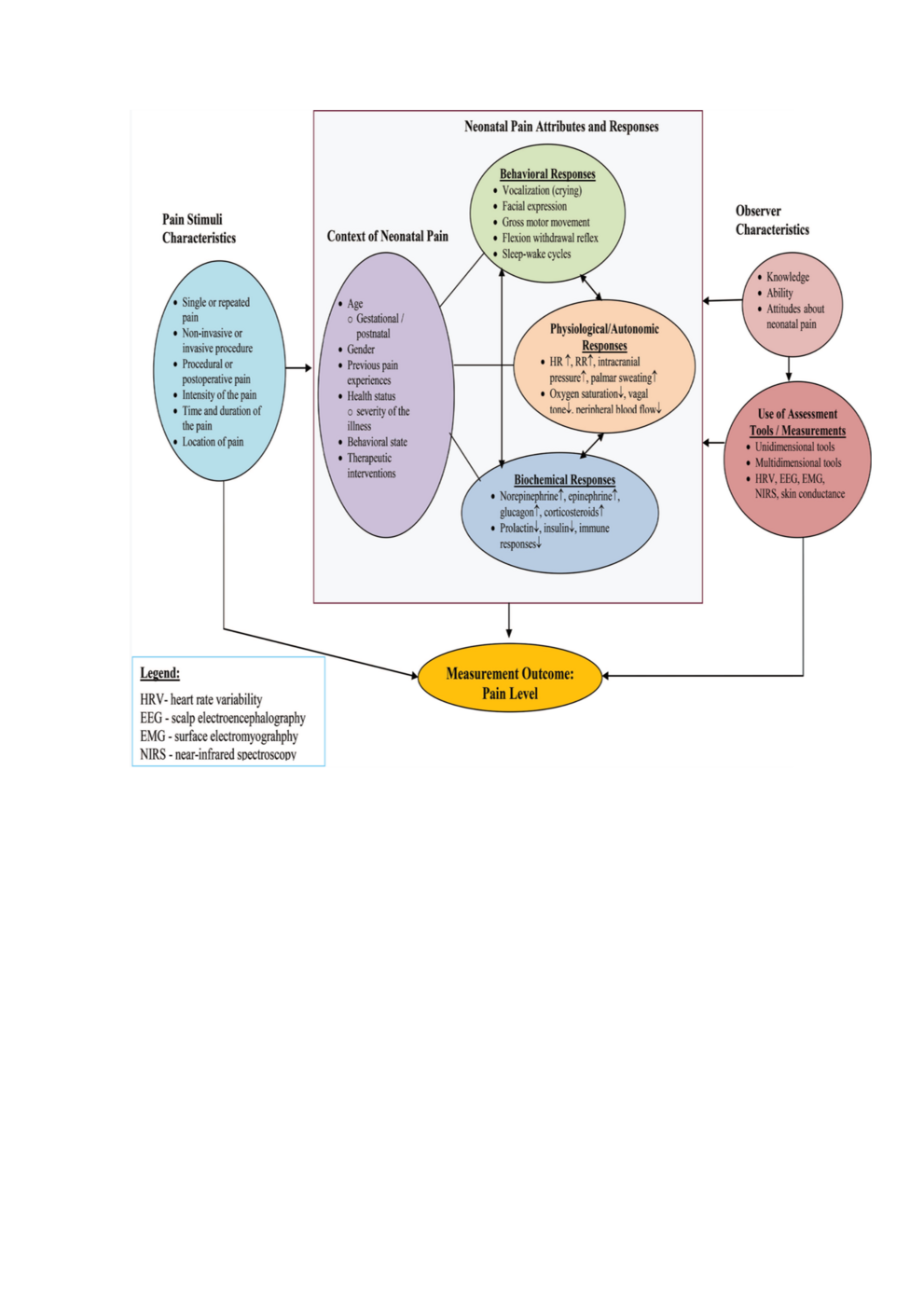Neonatal Pain Assessment: Difference between revisions
No edit summary |
No edit summary |
||
| Line 14: | Line 14: | ||
== Pain Assessment in Neonates == | == Pain Assessment in Neonates == | ||
Pain assessment is the path for pain management. For the assessment of pain, a standardized and validated outcome tool is necessary. Self-report is the best method for pain assessment as pain is subjective, but this assessment method is not suitable for newborns. So, observational and behavioral tools are the best substitutions.<ref name=":0" /><ref name=":1" /> | Pain assessment is the path for pain management. For the assessment of pain, a standardized and validated outcome tool is necessary. Self-report is the best method for pain assessment as pain is subjective, but this assessment method is not suitable for newborns. So, observational and behavioral tools are the best substitutions.<ref name=":0" /><ref name=":1" /> Several studies found around 40 pain assessment tools with different levels of validity<ref>de Melo GM, Lélis AL, de Moura AF, Cardoso MV, da Silva VM. Escalas de avaliação de dor em recém-nascidos: revisão integrativa [[https://pubmed.ncbi.nlm.nih.gov/25511005/ Pain assessment scales in newborns: integrative review]]. ''Rev Paul Pediatr''. 2014;32(4):395-402.</ref><ref>Eriksson M, Campbell-Yeo M. [https://pubmed.ncbi.nlm.nih.gov/30987943/ Assessment of pain in newborn infants]. ''Semin Fetal Neonatal Med''. 2019;24(4):101003.</ref>. | ||
== A Conceptual Framework For The Measurement of Neonatal Pain == | == A Conceptual Framework For The Measurement of Neonatal Pain == | ||
[[File: | [[File:Pain neonatal 2.png|alt=|center|thumb|1402x1402px|Neonatal pain assessment conceptual framework]] | ||
<ref name=":0" /> | |||
== Assessment Tools == | == Assessment Tools == | ||
A systematic review that analyzed neonatal pain assessment in 352 studies, found these six scales as the most frequently used: | A systematic review that analyzed neonatal pain assessment in 352 studies, found these six scales as the most frequently used in clinical practice<ref>Olsson E, Ahl H, Bengtsson K, et al. [https://pubmed.ncbi.nlm.nih.gov/32826760/ The use and reporting of neonatal pain scales: a systematic review of randomized trials]. ''Pain''. 2021;162(2):353-360.</ref>: | ||
-PIPP/PIPP-R (Premature Infant Pain Profile/ Revised) | -PIPP/PIPP-R (Premature Infant Pain Profile/ Revised) | ||
Revision as of 22:31, 14 April 2022
Pain[edit | edit source]
The International Association for the Study of Pain (IASP) defines pain as “An unpleasant sensory and emotional experience associated with, or resembling that associated with, actual or potential tissue damage.”[1]
Pain can be classified as nociceptive and neuropathic on the basis of pathology, nonmalignant and malignant on the basis of etiology, acute and chronic on the basis of duration and on the basis of location, it can be classified by body sites. [2]
Pain is now considered as the fifth vital sign hence it should be noted at any time. [2]
Neonatal Pain[edit | edit source]
Neonates have 30-40% lower pain threshold than the adult and other age group and they have lower pain tolerance. [3]
Premature infants are more sensitive to pain stimuli than full-term infants because of immature sensory processing and inhibition controls. It leads to lower thresholds for excitation and sensitization, thereby potentially maximizing the central effects of tissue-damaging inputs.[3]
Pain Assessment in Neonates[edit | edit source]
Pain assessment is the path for pain management. For the assessment of pain, a standardized and validated outcome tool is necessary. Self-report is the best method for pain assessment as pain is subjective, but this assessment method is not suitable for newborns. So, observational and behavioral tools are the best substitutions.[3][2] Several studies found around 40 pain assessment tools with different levels of validity[4][5].
A Conceptual Framework For The Measurement of Neonatal Pain[edit | edit source]
Assessment Tools[edit | edit source]
A systematic review that analyzed neonatal pain assessment in 352 studies, found these six scales as the most frequently used in clinical practice[6]:
-PIPP/PIPP-R (Premature Infant Pain Profile/ Revised)
-NIPS (Neonatal Infant Pain Scale)
-NFCS (Neonatal Facial)
-DAN (Douleur Aiguë Nouveau-né)
-Comfort-neo/Comfort/Comfort-B (Comfort Behavioral scale)
-N-PASS (Neonatal Pain Agitation and Sedation scale)
Other of the outcome tools used in the assessment are[3][2]:
- CRIES pain rating scale
- FLACC assessment tool
- Behavioral pain score
References[edit | edit source]
- ↑ https://www.iasp-pain.org/Education/Content.aspx?ItemNumber=1698#Pain
- ↑ 2.0 2.1 2.2 2.3 Kahsay H. Assessment and treatment of pain in pediatric patients. Current Pediatric Research. 2017.
- ↑ 3.0 3.1 3.2 3.3 3.4 Cong X, McGrath JM, Cusson RM, Zhang D. Pain assessment and measurement in neonates: an updated review. Advances in Neonatal Care. 2013 Dec 1;13(6):379-95.
- ↑ de Melo GM, Lélis AL, de Moura AF, Cardoso MV, da Silva VM. Escalas de avaliação de dor em recém-nascidos: revisão integrativa [Pain assessment scales in newborns: integrative review]. Rev Paul Pediatr. 2014;32(4):395-402.
- ↑ Eriksson M, Campbell-Yeo M. Assessment of pain in newborn infants. Semin Fetal Neonatal Med. 2019;24(4):101003.
- ↑ Olsson E, Ahl H, Bengtsson K, et al. The use and reporting of neonatal pain scales: a systematic review of randomized trials. Pain. 2021;162(2):353-360.







